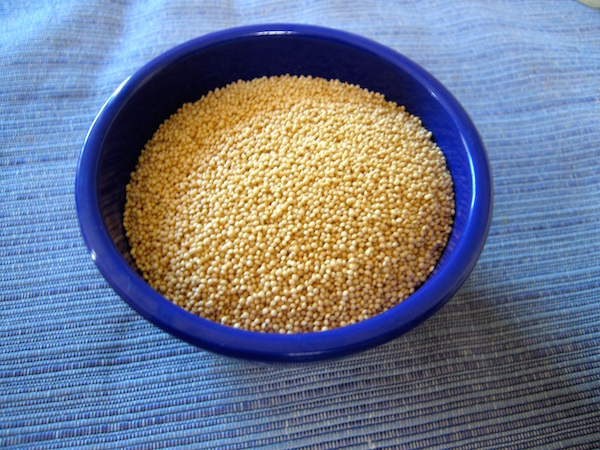
by plant4health | May 14, 2015 | cancer, Nutrition, Plant-based, Recipes, Vegan, WFPB, Whole food
 Recently, I’ve been experimenting with amaranth, both the seed and flour, in my cooking. I enjoy incorporating new textures and flavors into our meals. Amaranth provides a subtly sweet, earthy nuttiness, making it delicious in both sweet and savory dishes. Depending on how you cook it, from crispy chewy crackers to breakfast porridge, amaranth is a wonderful addition to your healing diet.
Recently, I’ve been experimenting with amaranth, both the seed and flour, in my cooking. I enjoy incorporating new textures and flavors into our meals. Amaranth provides a subtly sweet, earthy nuttiness, making it delicious in both sweet and savory dishes. Depending on how you cook it, from crispy chewy crackers to breakfast porridge, amaranth is a wonderful addition to your healing diet.
Amaranth, a major part in the Aztecs’ diet, has been around for thousands of years. It is naturally gluten-free and holds a powerhouse of nutrients. It contains more than three times the average amount of calcium found in grains and is high in protein, iron, magnesium, phosphorus, and potassium (1). Amaranth is also alkaline, making it a wonderful grain for those on an alkaline healing diet.
(more…)
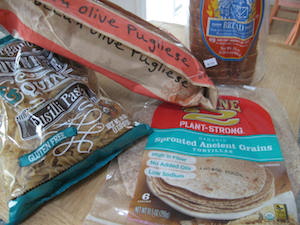
by plant4health | Mar 31, 2015 | Nutrition, Plant-based, Recipes, Vegan, WFPB, Whole food

Gluten-free has become a trendy buzzword among the health conscious. But is it right for everyone, even if you aren’t experiencing symptoms of having a gluten sensitivity?
What is gluten?
Gluten is a protein that naturally exists in wheat, rye, and barley and can be found in a variety of processed foods, including salad dressings and seasoning mixes. Gluten is also hiding in some vitamins, medications and makeup products. Gluten’s main claim to fame is its ability to help foods maintain its shape. That’s why it’s an essential part of baking. When combined with water, gluten’s strong, sticky protein gives structure to baked goods and pastas.
Gluten has become a popular meat substitute for vegans and vegetarians. High in protein, a four-ounce serving of seitan (a processed gluten meat substitute) contains about 26 grams of protein. Gluten is also low in fat and high in iron.(1)
When is gluten bad?
Gluten is harmful to people with celiac disease or a gluten sensitivity. When people with celiac disease (an autoimmune disorder) eat gluten it triggers an allergic reaction that results in inflammation and destruction to the lining of their small intestine and the malabsorption of nutrients. People with celiac disease tend to experience varying degrees of gastrointestinal issues, joint pain and skin rashes. In addition, studies have shown a link between celiac disease and neurological symptoms such as anxiety, depression, autism, epilepsy, and schizophrenia.(2) And there is strong evidence that individuals with autism, epilepsy, and schizophrenia all respond well to a gluten-free diet.(3) It only takes a very small amount of gluten (about 50 milligrams) to cause intestinal damage for a person with celiac disease. Learn more.
A related condition called gluten sensitivity or non-celiac gluten sensitivity can cause symptoms similar to celiac disease with an increase in the non-GI symptoms such as headaches, joint pain and numbness in the limbs and fingers. Individuals with gluten sensitivity lack the same antibodies as those with celiac disease and do not experience the same intestinal damage. Where celiac disease is considered an autoimmune disease, gluten sensitivity is an innate immune response where the immune system’s response does not target your own body’s tissues. (more…)
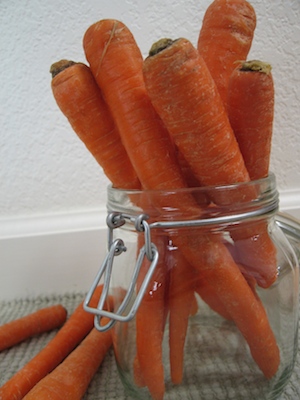
by plant4health | Mar 24, 2015 | Plant-based, Recipes, Vegan, WFPB, Whole food
 The nutritional power of everyday foods always amazes me. Perhaps because they are so readily available we overlook their healing capacity.
The nutritional power of everyday foods always amazes me. Perhaps because they are so readily available we overlook their healing capacity.
A common dipping tool for hummus and guacamole, a popular addition to salads and stews, the healing potential of carrots tends to be dismissed. In addition to containing many alkaline elements that assist your body in maintaining the acid-alkaline balance that is essential for optimal health, carrots have more than 490 phytochemicals. Each phytochemical provides different health benefits; some assist in detoxifying your body, others stimulate the immune system, modulate metabolism, and/or have antibacterial and antiviral qualities.
We all know about how the high amounts of the carotenoid beta-carotene found in carrots (that converts into vitamin A in our bodies) supports healthy vision, skin, and bones, but did you know that carrots are a great source of disease fighting flavonoids? These flavonoids provide antioxidants that work towards neutralizing free radicals that attack the cells of your body, protecting them from forming cancer cells, causing premature aging, and taxing your immune system.
Did you know that carrot juice is an effective diuretic? The combination of vitamins, minerals and antioxidants found in carrots promote detoxification and the elimination of excess water from your body.
But that’s not all. Below is a list of nutrients found in carrots. Raw or cooked, this vegetable holds a powerhouse of healing potential:  Below are some of the ways these nutrients play a vital role in your health, reducing your risk of chronic disease and cancer.
Below are some of the ways these nutrients play a vital role in your health, reducing your risk of chronic disease and cancer.
Heart Disease
The British Journal of Nutrition (Nov 2011) reported that consuming deep orange fruit and vegetables, especially carrots, may provide you with a 32% lower risk of coronary heart disease.
In addition, the antioxidants found in carrots work together synergistically to provide cardiovascular protective benefits. It is believed that obtaining any of these antioxidants in isolation from each other would not create the same effect. It is the nutrition from the whole food that provides the full health benefits.
The calcium found in carrots helps prevent the narrowing of blood vessels, the potassium promotes regular heartbeat, and the vitamin C protects cells against free radicals and strengthens blood vessel walls. Learn more here and here.
Cancer
Antioxidants in carrots, including vitamin C and beta-carotene, are known to play a significant role in cancer prevention; In 1986, a case-control study on the effect carrots and green vegetables have on lung cancer found that smokers who ate carrots more than once a week had a lower risk of lung cancer.
In 2011, a study investigated the effect of carrot juice extracts on leukemia and found evidence that carrot juice extract kills leukemia cells and inhibits their progression, making carrots an excellent source of bioactive chemicals to treat leukemia.
Fertility
According to the Harvard University School of Public Health (November 2013), eating foods rich in beta-carotene, like carrots, can boost male fertility, improving sperm motility by 6.5 – 8%.
Tips
Carrots are available in the grocery stores year-round. If you purchase your carrots at a farmers market with the greens attached, remove them before storing to prevent the greens from drawing out moisture and nutrients from the roots.
There are so many uses for carrots: shred them in salad and coleslaw, add them to wraps, steam or roast them for dinner, include them in muffins or cake to add a touch of sweetness, or juice them into a nutrient rich veggie drink.
Try one of these recipes:

by plant4health | Mar 17, 2015 | grocery shopping, Nutrition, Plant-based, Recipes, Vegan, WFPB, Whole food
 It seems counter-intuitive that eating a healthy plant-based diet costs more then an unhealthy diet full of processed foods. Although cheaper in the short run, the cost savings of eating an unhealthy western American diet is countered as you age with the increase in health costs due to diabetes, heart disease, strokes, autoimmune diseases, and other chronic illnesses.
It seems counter-intuitive that eating a healthy plant-based diet costs more then an unhealthy diet full of processed foods. Although cheaper in the short run, the cost savings of eating an unhealthy western American diet is countered as you age with the increase in health costs due to diabetes, heart disease, strokes, autoimmune diseases, and other chronic illnesses.
But the immediate increase in costs of healthy organic foods can shock the pocketbook, making it a challenge for those living on a tight budget. When given the choice between a cheap, quick, heat and serve processed meal or a slightly more expensive, healthy, make it yourself meal that takes conscious effort, the cheap quick and easy usually wins out.
The good news is eating a plant-based vegan diet doesn’t have to break the bank. According to a study completed at the Harvard School of Public Health in 2013, it only costs about $1.50 more per person per day to eat healthy. It just takes a little strategy to shift your food choices and purchasing habits in order to keep the costs down. Here are some suggestions to help you save money: (more…)
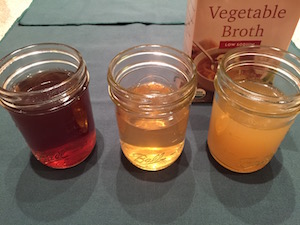
by plant4health | Feb 27, 2015 | Plant-based, Recipes, Vegan
Vegetable broth is handy to have on hand for making rice dishes, risotto, and soups. It’s convenient to buy at the store but be sure to look carefully at the ingredients. Some list carrots as the first ingredient and the broth can be orange in color and very sweet. Some manufacturers such as Whole Foods brand add a bit of sugar and oil which is best to avoid. Trader Joe’s Organic Hearty Vegetable Broth has carrots as the first ingredient but does not add sugar or oil. Try a few brands to see what you prefer.
Of course the best broth is what you make from scratch. It’s not difficult, just takes a bit of advanced planning. But it’s worth it. You can control how intense you want the flavors to be and design it for the dish you are making.
A time-saving (and money-saving) tip is to save clean vegetable trimmings in a gallon freezer bag as you are cooking other meals or making salads. You can use theses scraps that would otherwise get composted to make broth. Save onion and shallot peels and the ends of leeks and green onions; carrot and potato peels, ends of celery (and their leaves), chard stems and bell pepper. In a separate bag save mushroom ends. You’ll add the mushrooms if you want a darker, earthier flavor, especially if you are making a mushroom risotto. You can also add fennel which will give a licorice flavor. Avoid cruciferous veggies such as broccoli and cabbage as they will add a bitter taste. Red beets will turn it red.
You can make a broth using just the scraps plus herbs (see recipe below) or add additional vegetables which you can roast or sauté first if you want a more intense flavor. Here is a wonderful basic broth recipe from Anna Thomas, featured on Epicureous.
For a broth just from the scraps, use this recipe from thegardenofeating.org:
- Place 4-6 cups of scraps in a soup pot or dutch oven and add
- 1 bay leaf
- 3-5 cloves of garlic, peeled
- 4 branches of Italian parsley
- A sprig of thyme or 1 teaspoon dried thyme
- Cover with water, about an inch above the veggies, bring to a boil and simmer uncovered for about 45 minutes.
- Strain the broth through a colander lined with cheesecloth or a strainer.
If not using the broth right away, let it cool completely and freeze it in a freezer-proof container or ice cube trays, or store for up to five days in the refrigerator.
![The Amazing Healing Powers of Beets]()
by plant4health | Feb 24, 2015 | grocery shopping, Plant-based, Recipes, Whole food
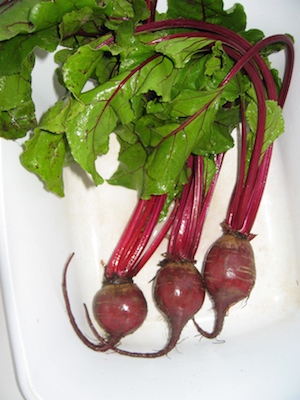 Beets are amazing! Packed full of vitamins and minerals, they are an important addition to any healing diet. Here’s just a few reasons why: (more…)
Beets are amazing! Packed full of vitamins and minerals, they are an important addition to any healing diet. Here’s just a few reasons why: (more…)

 Recently, I’ve been experimenting with amaranth, both the seed and flour, in my cooking. I enjoy incorporating new textures and flavors into our meals. Amaranth provides a subtly sweet, earthy nuttiness, making it delicious in both sweet and savory dishes. Depending on how you cook it, from crispy chewy crackers to breakfast porridge, amaranth is a wonderful addition to your healing diet.
Recently, I’ve been experimenting with amaranth, both the seed and flour, in my cooking. I enjoy incorporating new textures and flavors into our meals. Amaranth provides a subtly sweet, earthy nuttiness, making it delicious in both sweet and savory dishes. Depending on how you cook it, from crispy chewy crackers to breakfast porridge, amaranth is a wonderful addition to your healing diet.





